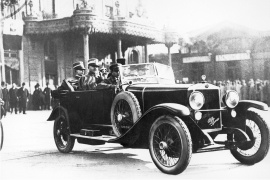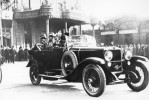Body style: Convertible (spider/spyder, cabrio/cabriolet, drop/open/soft top)
Segment: Roadster & Convertible
Production years: 1922, 1923, 1924, 1925, 1926, 1927

Soon after World War I, Alfa Romeo resumed production, and the RL lineup was the first model unveiled by the Italian automaker and became famous thanks to its racing results.
Alfa Romeo knew that motorsports was the best way to promote its products. As a result, when it developed the RL, it made it in a few versions so it could win races. The car was introduced in 1922 and was available in the Sport and the Normale grades, with a higher power version for the former. The car was developed by Giuseppe Merosi, the carmaker’s chief engineer. He created a chassis that could handle both engines and an engine that could be improved for races. Usually, in those times, the only thing that a customer could choose from a brand was the vehicle’s body shape. Alfa Romeo delivered the RL as a torpedo, roadster, or rolling chassis to customers wishing to finish the bodywork at specialized coachbuilders, such as Zagato. Alfa Romeo entered four cars in the 1923 Targa Florio race, driven by Ugo Sivocci, Antonio Ascari, Giulio Masetti, and Enzo Ferrari. Each of them represented one of the cloves painted on the car’s bodywork and started the legend of the four cloverleaves legend after the former two sealed the race with a one-two podium finish.
The Italian engineer made the car with a dihedral-shaped radiator and a flat front area. In front of it, on a cross beam, it placed the big and round electric headlights. A pair of thin fenders barely covered the skinny wheels. Merosi didn’t include a front bumper for the vehicle, so the semi-elliptic leaf springs that supported the beam axle were exposed.
From its sides, the RL torpedo featured side steps that emerged from the front fenders and spare wheels attached to the engine compartment. The wire wheels were normal for those times, and both versions of the RL featured them. Surprisingly, for a four-door vehicle, was the split windshield. Merosi couldn’t place a curved glass to lower the drag, so he installed two pieces connected via a vertical slat. The retractable roof could be stored behind the cabin when not in use, and a vertical flat and vertical panel ended the car’s profile.
Depending on the version, the RL was available with up to three rows of seats, allowing six occupants to sit inside the cabin. Customers also could order the vehicle with two rows, so the rear-seated ones could enjoy better legroom and more comfort. The driving position was on the right, and the dials and gauges were placed in the middle of the dash panel.
Despite being developed as a race-capable vehicle, the RL featured drum brakes on the rear axle only. In the Normale version, the car had a longer wheelbase, and its three-liter engine produced just 56 PS (55 hp), while the Sport version provided 71 PS (70 hp). Both shared the same four-speed manual gearbox with a floor-mounted stick.
ALFA ROMEO RL 1922, 1923, 1924, 1925, 1926, 1927
- 2.9
ALFA ROMEO RL
2.9
ENGINE SPECS - 2.9 | |
|---|---|
| Cylinders: | L6 |
| Displacement: | 2916 cm3 |
| Power: | 62 KW @ 3600 RPM 83 HP @ 3600 RPM 83 BHP @ 3600 RPM |
| Fuel System: | Carburetor |
| Fuel: | Gasoline |
PERFORMANCE SPECS | |
|---|---|
| Top Speed: | 68.4 mph (110 km/h) |
TRANSMISSION SPECS | |
|---|---|
| Drive Type: | Rear Wheel Drive |
BRAKES SPECS | |
|---|---|
| Front: | Drums |
| Rear: | Drums |
DIMENSIONS | |
|---|---|
| Front/rear Track: | 57.5/57.5 in (1,461/1,461 mm) |
| Wheelbase: | 122.8 in (3119 mm) |
